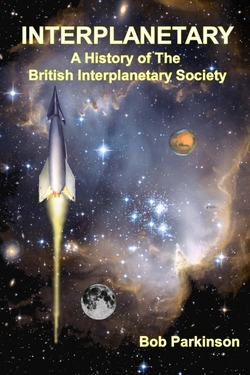Centauri Dreams
Imagining and Planning Interstellar Exploration
‘Blue Binaries’ Argue for Smooth Neptune Migration
We’re getting a few clues about the nature of planet migration in the early Solar System thanks to a class of objects being described as ‘blue binaries.’ Cold Classical Kuiper Belt Objects (CCKBOs) are generally reddish, but a population of widely separated binaries has now been identified that is thought to have originated in the inner edges of the Kuiper Belt.
The paper reporting on this work argues that these objects were pushed out a distance of over 4 AU to their present location among the CCKBOs as the result of gravitational interactions with Neptune billions of years ago, a movement induced by the migration of the planet from 20 to 30 AU. If so, we can draw some conclusions about that migration, and we’re reminded in the process of how rich the Kuiper Belt is in objects of different origins.
Led by Wes Fraser (Queen’s University, Belfast), the study used data drawn from the Gemini North instrument and the Canada-France-Hawaii Telescope, both on Mauna Kea, as part of a project called the Colors of the Outer Solar System Origins Survey. The team went to work on spectral data in a range of wavelengths from the ultraviolet to the optical and near-infrared. Its conclusion, reached by checking against models of Neptune’s migration, is that the blue binary pairs moved outward slowly enough that they were not disrupted into single objects.

Image: Artist’s conception of a loosely tethered binary planetoid pair like those studied by Fraser et al. in this work, which led to the conclusion that Neptune’s shepherding of them to the Kuiper Belt was gradual and gentle in nature. Credit: Gemini Observatory/AURA, artwork by Joy Pollard.
Let me quote from the paper re the team’s simulations:
The idea that the blue CCKBO binaries are contaminants that were pushed out into cold classical orbits during Neptune’s migration agrees well with the hypothesis that the blue–red bifurcation of the excited KBO colour distribution is a result of an object’s heliocentric formation distance. In our simulations, surviving binaries were pushed out by no more than 6 au, originating in the ?38–40 au range. Similar simulations suggest that the red-coloured, widely separated binary 2007 TY430, which now resides in the 3:2 MMR [mean motion resonance], plausibly originated at ?37–39 au, but could have originated even further out . This would require that the distance inside which blue binaries originated was only a handful of au inside the current inner edge of the cold classical region.
The Kuiper Belt contains a heterogeneous population indeed. Work by Alex Parker (University of Victoria, BC) and J.J. Kavelaars (Herzberg Institute of Astrophysics, Canada) tells us that the Cold Classical Kuiper Belt Objects are the only part of the Kuiper Belt population that formed in place. These objects share a reddish color, low inclinations and low eccentricities, a contrast to a population of dynamically excited objects that come in a range of colors.
Whereas this latter group is comprised of only about 10 percent binaries, the Cold Classical Kuiper Belt Objects exist as binary pairs about 30 percent of the time. The newly discovered blue binaries, though, distinguish themselves from both camps. In an email this morning, Dr. Fraser told me that while a few blue objects were previously known to exist in this region, his team had realized that the blue objects they were studying all came in binary pairs: “It was the discovery of blue+binary together that showed us we were looking at something special.”
Moreover, the binary nature of the objects as the products of Neptune’s ‘push out’ demands that they originally formed as multiple objects. From the paper again:
This push-out scenario would have the startling implication that virtually all planetesimals that formed in the region from which the blue binaries originated must either have formed as binaries or higher multiplicity systems, or attained high multiplicity before push-out occurred. This is required by the fact that all but one of the blue CCKBOs are found in binary pairs.
Thus we can see the blue binaries, originating at about 38 AU, as contaminants that in the paper’s language “…could provide a unique probe of the formative conditions in a region now nearly devoid of objects.” The paper explores various formation scenarios for these binaries that include pebble accretion and later binary production as well as binary formation from the collapse of a cloud of gas and solids that produces bound systems of two or more objects.
The paper is Fraser et al., “All planetesimals born near the Kuiper Belt formed as binaries,” published online by Nature Astronomy 4 April 2017 (abstract). The paper by Parker and Kavelaars cited above is “Destruction of binary minor planets during Neptune scattering,” Astrophysical Journal 722, L204–L208 (2010) (full text).

New Options for Locating Fast Radio Bursts
Our catalog of distant, highly energetic events continues to grow. On the Fast Radio Burst (FRB) front, we have the welcome news that the Molonglo radio telescope some 40 kilometers from Canberra, Australia has undergone extensive re-engineering, a project that is paying off with the detection of three new FRBs. The telescope’s collecting area of 18,000 square meters and an eight square degree field of view make it ideal for such work.
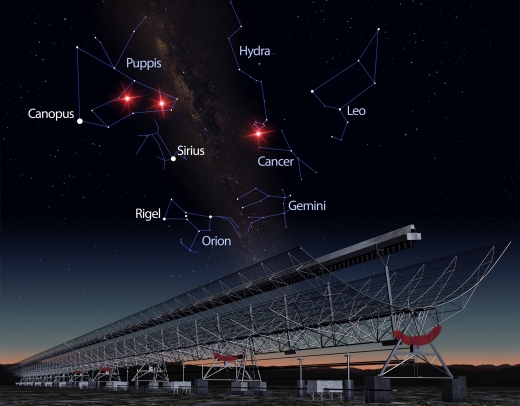
Image: Artist’s impression shows three bright red flashes depicting Fast Radio Bursts far beyond the Milky Way, appearing in the constellations Puppis and Hydra. Credit: James Josephides/Mike Dalley.
You’ll recall that Fast Radio Bursts are millisecond long, intense pulses that can appear out of nowhere with a luminosity a billion times greater than anything we have observed in the Milky Way. The phenomenon was noted for the first time a decade ago at the Parkes radio telescope in New South Wales. The sources remain enigmatic, but Manisha Caleb, a PhD candidate at Australian National University, has been developing software to examine the 1000 TB of data that is being produced daily at the Molonglo site. The new FRBs are the result.
“Conventional single dish radio telescopes have difficulty establishing that transmissions originate beyond the Earth’s atmosphere,” says Swinburne University’s Dr Chris Flynn.
But Molonglo (the Molonglo Observatory Synthesis Telescope, to give its full name, usually shortened to MOST) is a parabolic, cylindrical antenna consisting of 88 bays, each of these made up of four identical modules, to produce 352 independent antennae. The upgrade to the Molonglo instrument is known as UTMOST. The researchers used the array in a 180-day survey of the Southern sky, carrying out up to 100 hours of follow-up for each FRB, though no repeating bursts were seen. A repeating burst at UTMOST, or an FRB simultaneously detected at Parkes and UTMOST, would allow a localization of a few arcseconds.
From the paper (note that ” is the symbol for arcseconds):
In this paper we present the first interferometric detections of FRBs, found during 180 days on sky at UTMOST. The events are beyond the ≈ 104 km near-field limit of the telescope, ruling out local (terrestrial) sources of interference as a possible origin. We demonstrate with pulsars that a repeating FRB seen at UTMOST has the potential to be localised to ≈ 15″ diameter error circle, an exciting prospect for identifying the host.
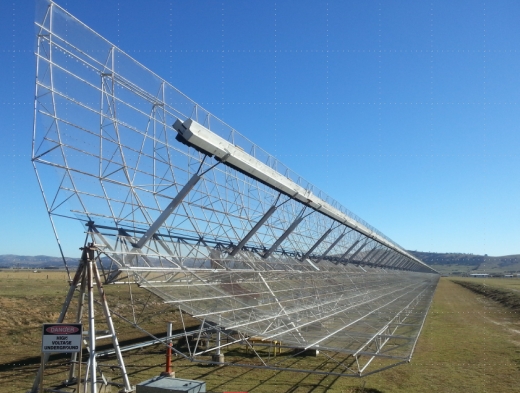
Image: View of the MOST at the end of the East arm looking West. Two arms, each 800 meters long, together have a collecting area of circa 18,000 square meters. MOST is the largest radio telescope in the Southern hemisphere. Credit: Swinburne University/UTMOST.
The recent discoveries point to a new ability to locate FRBs in the sky, allowing us to link them to specific galaxies, a feat that has been accomplished only once so far (see Pinpointing a Fast Radio Burst). The paper is Caleb et al., “The first interferometric detections of Fast Radio Bursts,” accepted at Monthly Notices of the Royal Astronomical Society (preprint). For more, see this UTMOST news release.

Building the Tools for Icy Moons
With my own memories of the July 4, 1997 landing of Mars Pathfinder at Chryse Planitia as fresh as yesterday, it’s hard to believe that we are looking at the 20th anniversary of rover operations on the planet. But as the Curiosity rover continues its travels and we look toward the Mars 2020 rover mission, we’re also taking a much longer look ahead at the worlds where life may be more likely to be found, the icy moons of Jupiter and Saturn.
Ponder this: Testing at the Jet Propulsion Laboratory is showing that ice grains in conditions like we will encounter on places like Enceladus or Europa can behave like sand dunes. That means fine grains that could stall an improperly designed rover, leading NASA engineers to begin rethinking designs harking back to the early days of Moon exploration, lightweight commercial wheels attached to a flexible chassis, a system that has worked for a variety of missions but will need adjustment for future work. The rovers that use these systems will, in the case of moons like Europa, need serious attention to radiation hardening.
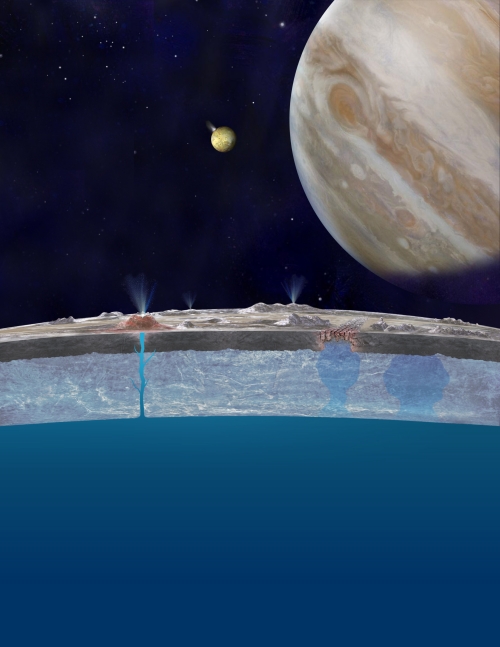
Image: Artist’s concept of Europa’s frozen surface. Credit: JPL-Caltech.
The project looking into extreme environments for these next generation rovers is called the Ocean Worlds Mobility and Sensing study, which is developing prototypes for sample acquisition on icy moons. Working tricky environments like Enceladus means coping with fissures that blow jets of material out into space. And Europa’s challenge goes far beyond Jupiter’s cascading radiation given the need to get through surface ice to sample the subsurface ocean. On Titan, we prepare for a possibly mushy ethane-rich surface.
“In the future, we want to answer the question of whether there’s life on the moons of the outer planets — on Europa, Enceladus and Titan,” says Tom Cwik, who leads JPL’s Space Technology Program. “We’re working with NASA Headquarters to identify the specific systems we need to build now, so that in 10 or 15 years, they could be ready for a spacecraft.”
The Europa work is particularly interesting given the question of astrobiology in the Europan ocean. The biggest problem for designers right now is that we have no certainty about the thickness of the surface ice, which could conceivably extend as deep as 20 kilometers. Richard Greenberg has argued in Unmasking Europa (Copernicus 2008) that the evidence of surface melt-through of Europan ice points to ice as thin as five kilometers. Whatever the case, so-called ‘melt probe’ designs are being scaled up for the challenge.
The JPL work on melt probes is led by Brian Wilcox, who has concluded that the thickness of Europan ice, in comparison with the Earth ices that conventional melt probes have coped with, demands an emphasis on heat efficiency. Wilcox is examining a vacuum-insulated capsule that uses a heat source like plutonium to keep its energy as it sinks into the ice. At one end, a rotating sawblade turns and cuts ever deeper, while pushing ice chips into the body of the probe, where they are melted and pumped out behind it.
The idea is that the water would be sampled in the midst of this process, with some being returned to the surface lander through pneumatic tubing. There it would be checked for biosignatures. And given concerns about possible contamination by Earthly life, Wilcox would heat the probe to almost 500° C during the cruise phase of the flight, thus killing off any residual organisms that may be hitching a ride from Earth.
“We think there are glacier-like ice flows deep within Europa’s frozen crust,” Wilcox said. “Those flows churn up material from the ocean down below. As this probe tunnels into the crust, it could be sampling waters that may contain biosignatures, if any exist.”
This JPL news release offers more, including work on a new generation of robotic arms that will out-reach our Mars rovers, which have never extended beyond about 2.5 meters from the base unit. JPL is looking at a robotic arm with a 10 meter extension, and is also considering a projectile launcher that can fire a sampling mechanism to distances of 50 meters. Having obtained the sample, the device would be reeled in by a tether.
These technologies are designed to be used along with an ice-gripping claw which could have a coring drill attached to it for taking surface samples at locations of interest. The drill would be able to reach about 20 centimeters below the surface ice. The ice claw itself would be deployed from a boom arm and would anchor itself with heated prongs that melt into the ice to secure the unit. It would then penetrate the ice with its drill bit to collect the needed sample.
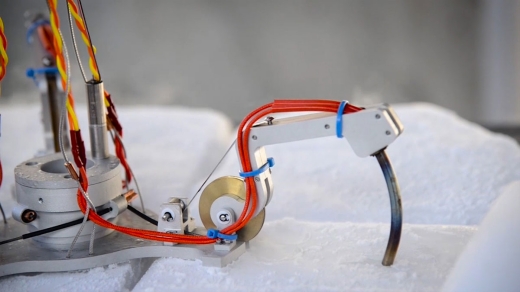
Image: A robotic claw, one of several innovative tools developed at JPL for exploring icy, ocean worlds like Europa. Credit: NASA/JPL-Caltech.
The Ocean Worlds Mobility and Sensing site is sparse at the moment but it’s one you might want to keep an eye on as the effort continues. NASA is considering a second phase of the study that would be tapped as we work out the overall design of any icy moons lander.

Where Do We Come From? What Are We? Where Are We Going?
Is there something about human beings that ensures we will always explore? I think so, even while acknowledging that there are many who have chosen throughout history not to examine potential frontiers. The choices we make on Earth will be reflected in our future beyond the Solar System, assuming there is to be one. Nick Nielsen looks at these questions in a historical context today, seeing history as a fractal structure, but one whose future is not clear. A path that can lead to the stars as our destination is available in what he describes herein as a new stage of growth not limited by a single world and large enough to contain projects on a planetary scale. When he’s not writing for Centauri Dreams, you can follow Nick’s work on Twitter @geopolicraticus or on his blog Grand Strategy: The View from Oregon.
by J. N. Nielsen

The human condition: questions and answers
What is perhaps Paul Gauguin’s best known painting —D’où Venons Nous / Que Sommes Nous / Où Allons Nous [1] — depicts a panorama of the stages of human life against the backdrop of the ordinary business of life on Gauguin’s adopted home in Tahiti. The questions that Gauguin painted into the upper left corner of this painting — Where Do We Come From? What Are We? Where Are We Going? — are as relevant as ever, but how we answer them, or how we attempt to answer them, has changed over time. In the past, mythological answers sufficed, partly because mythology presents the human condition in concrete and intuitively tractable forms [2] and partly because there was no other conceivable form for the answers to such far-reaching questions to take. Today, however, we can conceive of a non-mythological approach to answering the perennial questions of human nature and the human condition.

Possibly for the first time in human history we are in a position to offer scientific answers to the perennial existential questions of the human condition, and this, I think, is all to the good. Mythology will always play a role in human life, but there as yet exists no mythology that has grown out of our industrialized civilization, and consequently no mythology that is adequate to understanding this civilization or to understanding our place within this civilization. If we are going to understand ourselves on our own terms, on terms familiar to the world we have built for ourselves with science, technology, and engineering, we are going to have to understand ourselves through science.
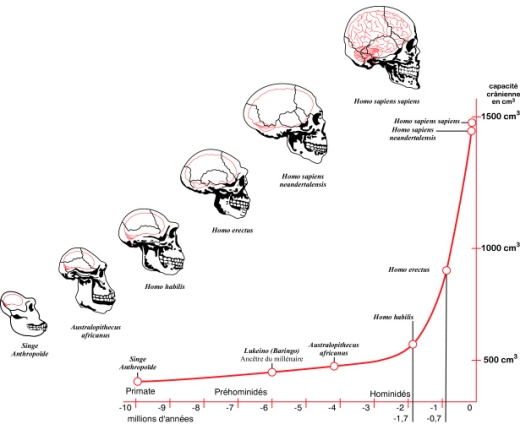
Where we’ve been
“Where do we come from?” is now a question of history, and particularly of scientific historiography that has expanded far beyond the history of humanity as documented in written sources, drawing upon biology, paleontology, anthropology, archaeology, and a dozen other disciplines which, when integrated, give us comprehensive overview of the origins of human beings.
Human history, if extended to the origin of our species, comprises more than five million years, that is, more than five million years since the last common ancestor of humanity and the other primates. Very little happened during several million years of increasing encephalization and virtually unchanged stone toolkits. But if you were to look at human history as a graph of several parameters used to quantify and measure intelligence and intelligent activity, from a distance this graph would look like an exponential growth curve, being first of all the curve defined by human encephalization. [3]
If you move in closer to this graph, instead of looking at millions of years, looking at the tens of thousands of years elapsed since anatomical modernity (after encephalization attained modern levels) and cognitive modernity (when that encephalization began to express itself in distinctively human forms), once again the graph would look like an exponential growth curve, with the initial wave of technological and artistic expressions of the upper Paleolithic—painting, sculpture, music, more sophisticated tools of bone, and flint and obsidian industries that truly can be called “industries.”
If we look even more closely, at the last few thousand years, once again we see an exponential growth curve, as humanity settled the planet entire and civilization itself began, quantified by the number, diversity, and density of human settlements. And finally, if we look at a scale of only a few hundred years, once again we see an exponential growth curve (especially in the human population, due to reduced morality as a result of better nutrition and scientific medicine) as industrialization and then electrification dramatically changed the world in which we live.
You will already have guessed what I am suggesting: human history is a fractal in which there is a self-similarity across multiple scales of historical magnification. If this fractal structure of human history is extrapolated into the future, further exponential growth is implied. But what form could future exponential growth take? The instances I have mentioned have ranged from physical anthropology through cognitive modernity to social organization. It would be difficult to reduce these instances of exponential growth to a single class, except to note (as has already been noted) that all have been manifested in human history, therefore all are, in a sense, a function of the human mind.
The past testifies to the fractal structure of human history, but the future of this fractal structure is not at all clear—not even what human capacities or activities might be involved in future exponential growth—nor is there any certainty that this pattern will continue. Of the fractal structure of human history, all that we can say at present is that this is where we have been and this is what we have done as a species. It is an unprecedented history in the context of all life on Earth, and inductively this suggests an unprecedented future, but inductive arguments are probabilistic rather than certain and apodictic.

Where we are now
“What are we?” Where we are now is a function of what we are, and what we are is a function of our history. As we have seen above, scientific historiography can provide us with an overview of the expanses of human history previously closed to us when our only source of history was derived from written documents. While the selection pressures that act upon us over the longest time scales made us what we are today, human beings have changed the environment in which humanity lives (a process known in ecology as “niche construction“) and in so doing have reflexively subjected themselves to selection pressures of their own making. Chief among these human selection pressures is the large-scale social organization that we call “civilization.”
The civilization that we have today has been called by many names; I call this kind of civilization “industrial-technological civilization,” and it is uniquely characterized by a positive feedback cycle (which I call the “STEM cycle“). Science seeks to understand nature on its own terms, for its own sake. Technology is that portion of scientific research that can be developed specifically for the realization of practical ends. Engineering is the industrial implementation of a technology. Moreover, industrial technologies can be used to produce better scientific instruments, yielding yet more scientific knowledge and driving the cycle forward. Mathematics is the common language that connects the elements of the cycle and integrates them in a tightly-coupled structure.
Science produces knowledge, but technology only selects that knowledge from the scientific enterprise that can be developed for practical uses; of the many technologies that are developed, engineering selects those that are most robust and reproducible to create an industrial infrastructure to supplies a mass consumer society. The achievements of technology and engineering are in turn selected by science in order to produce novel and more advanced forms of scientific instrumentation, with which science can produce further knowledge, thus initiating another generation of science followed by technology followed by engineering.
In some cases the STEM cycle is only loosely-coupled. The resources of advanced mathematics are necessary to the expression of physics in mathematicized form, but there may be no direct coupling of physics and mathematics, and the mathematics used in physics may have been available for generations. Pure science may suggest a number of technologies, many of which lie fallow, with no particular interest shown in them. One technology may eventually come into mass manufacture, but it may not be seen to have any initial impact on scientific research. These episodes can only be understood as part of a loosely-coupled cycle when seen in the big picture and over the long term.
In this loosely-coupled sense, all civilization could be said to be characterized by the STEM cycle.
What distinguishes civilization today is an increasingly tightly-coupled STEM cycle in which incremental but continuous advances in science, technology, and engineering are predictable, and in some cases can be systematically pursued. In a highly specialized way, the R&D departments of large business enterprises comprise the entire STEM cycle, as applied to a particular problem or some particular aspect of human experience, within a single institution. We can, in other words, engineer the STEM cycle itself in order to maximize (or to specialize) its productivity of scientific knowledge, technological innovation, and industrial engineering.

Image: City planning in the ancient world.
How we got to where we are now
We got to where we are today, in terms of our civilization, by the tightening of the STEM cycle from a loosely-coupled cycle to a tightly-coupled cycle. The inflection point of this tightening was the industrial revolution, which resulted in a new kind of civilization as the consequence of a sudden and rapid tightening of the STEM cycle. But this is only the latest iteration of civilization, the entire history of which (like the fractal history of humanity on the whole) exhibits numerous inflection points beyond which human life was rapidly transformed.
The most remarkable feature of how we got from the origins of our species to the complex and sophisticated civilization we have today is that, with few exceptions, none of it was planned. Technology was not planned; civilization was not planned; industrialization was not planned; the internet was not planned. These things all happened, and they might just as readily have happened otherwise; any survey of history is strewn with obvious counterfactuals, i.e., paths not taken.
Certainly it can be said that individual projects undertaken by individuals, institutions, and in some cases entire communities have been carefully planned and systematically executed. The first cities of our earliest history were not planned, but urban planning rapidly emerged in antiquity and now the planning of cities—arguably, the centers of civilization, and the existence of which is sometimes taken by archaeologists to be the defining marker of civilization [4]—is routine. While individual cities may be planned, the overall historical structure of urbanization has not been planned, nor is it planned today; no one planned that humanity should become a majority urban species. The great movements of human history, built up from the collective but uncoordinated actions of billions of individuals living and dead, were not planned, and still elude planning.
Nineteenth and twentieth century attempts to create planned communities (to say nothing of planned civilizations) on a utopian model were almost all dismal failures. Utopian dreams were almost without exception transformed into dystopian nightmares, and the practice of community never coincided with the theory of community. Moreover, even the great unplanned movements of human history also eventually came to grief. Civilizations, cities, and the great works of humanity have been painstakingly constructed only to be abandoned or thrown down in great wars and violent convulsions of history.
Civilization has stumbled many times in human history, and this is due in part to a failure to understand what civilization is, which has meant the absence of purposeful, knowledge- and evidence-based intervention in history to sustain and grow civilization. We have gotten by, as Kenneth Clark said, by the skin of our teeth. [5] We cannot count on being lucky indefinitely. But, as we have seen, civilization appears resistant to planning. We have not yet been able to understand (let alone effectively intervene in) the basis of our own large-scale social cooperation.
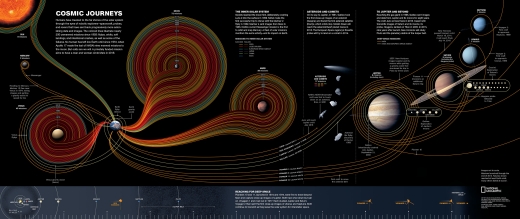
Image: Our journey into the cosmos starts by following the lead of our robotic probes.
Where we need to be
If we value the goods human beings have produced throughout our history, if we find in the artifacts of human civilization goods of intrinsic value worthy of preservation [6], then we ought to take action to secure the blessings of civilization for ourselves and our posterity—or for any other sentient-intelligent species that might come to appreciate the unique intrinsic values produced by human civilization. [7]
As a civilization, we need to be in a position in which we can ensure the continuing growth of knowledge, the establishment of multiple independent centers of civilization, and the autonomy of these distinct centers of civilization in order that social and political experimentation is maximized in order to secure for humanity the implementation of the broadest possible range of strategies for existential risk mitigation. [8]
At the stage of development of civilization that we have today, this means ensuring the continuation (if not the acceleration) of the STEM cycle, while extending our civilization across as many gravitational thresholds as our increasing technology allows us, i.e., passing beyond an exclusive reliance on Earth and becoming what Elon Musk has called a “multi-planetary species.” For beings such as ourselves, becoming a multi-planetary species is predicated upon becoming a spacefaring civilization, because it is only through spacefaring that we will reach other worlds.
Firstly we need a human presence in Earth orbit beyond the International Space Station (ISS), then a human presence throughout the solar system, then a human presence beyond the solar system. Each of these steps for spacefaring civilization is the overcoming of a gravitational threshold, much as our now-ubiquitous air travel overcame the topographical (and gravitational) threshold of seas and mountain ranges and the challenge posed by distance. With each gravitational threshold we transcend we gain a new opportunity for the redundancy of our civilization at an ever-greater distance from our homeworld (which entails proportionally greater independence and autonomy), as well as acquiring technological abilities that can contribute to the success of these independent centers of civilization and to the continued outward expansion of independent centers of civilization on the farthest frontier brought within our technological capability.

Image: Gilbert Murray and his classic study Five Stages of Greek Religion.
What are the obstacles to getting where we need to be?
The current consensus that appears to be emerging is that the greatest existential threat to humanity and human civilization is what may become of artificial intelligence, especially in the form of superintelligence. [9] I do not share this view, but I will not here attempt to make the argument against AI as an existential risk, as the exposition of this argument needs a time and place of its own.
As I see it, the greatest danger we face, the existential risk that ought to concern us all as human beings, is stagnation [10], or what classical historian Gilbert Murray called a failure of nerve. Here is how Murray opens his chapter on the failure of nerve in Five Stages of Greek Religion:
“Any one who turns from the great writers of classical Athens, say Sophocles or Aristotle, to those of the Christian era must be conscious of a great difference in tone. There is a change in the whole relation of the writer to the world about him. The new quality is not specifically Christian: it is just as marked in the Gnostics and Mithras-worshippers as in the Gospels and the Apocalypse, in Julian and Plotinus as in Gregory and Jerome. It is hard to describe. It is a rise of asceticism, of mysticism, in a sense, of pessimism; a loss of self-confidence, of hope in this life and of faith in normal human effort; a despair of patient inquiry, a cry for infallible revelation; an indifference to the welfare of the state, a conversion of the soul to God. It is an atmosphere in which the aim of the good man is not so much to live justly, to help the society to which he belongs and enjoy the esteem of his fellow creatures; but rather, by means of a burning faith, by contempt for the world and its standards, by ecstasy, suffering, and martyrdom, to be granted pardon for his unspeakable unworthiness, his immeasurable sins. There is an intensifying of certain spiritual emotions; an increase of sensitiveness, a failure of nerve.” [11]
Obviously, the world Murray is describing—and, indeed, the transition between two worlds that he is describing—is very different from our world and the transitions that our world suggests. Despite the distance between the world of late antiquity and our world today, there are certain parallels that can be observed. The pessimism Murray describes has its parallel in contemporary dystopianism and the casual cynicism shown to hopeful visions of the future. Instead of asceticism, we have its antithesis, indulgence—but both are focused on the welfare of the self above all.
Have we lost our self-confidence, our hope in this life and in normal human effort? Kenneth Clark in his Civilisation: A Personal View, seems to have held a view much like that implicit in Murray’s remarks quoted above. Clark wrote that civilization requires, “…confidence in the society in which one lives, belief in its philosophy, belief in its laws, and confidence in one’s own mental powers.” [12] Ask yourself if you know anyone who possesses confidence in this measure. I would be surprised if a great many responded that they did. This is simply not the character of our civilization today. Such confidence expressed today would, I think, be characterized in the most unflattering way.
That we have the technology today to do much more than we are doing at present in order to mitigate existential risk, and yet little is being done to ensure the continuity of civilization and the biosphere for the long term, is evidence of our lack of confidence in our own future. That is to say, we are already showing signs of stagnation and of disinterest in the world. In the second half of the twentieth century we saw the emergence of a counterculture that explicitly placed itself at odds with “the establishment,” embodied in such popular slogans such as “small is beautiful” and “the limits to growth.” [13] This movement celebrated a retreat from the wider world and the attempt to make oneself perfect on one’s own terms, within a tightly circumscribed horizon. This attitude must be understood as a perennial aspect of the human condition (Murray described it as such, if we understand this retrenchment from modernity as an instance of failure of nerve), and as an embodiment, in an Age of Technology, of the Romantic rebellion against the rationalism of the Enlightenment, which latter was, in turn, a reaction against the irrational horrors of the Thirty Years War and the witch craze that swept early modern Europe and America.
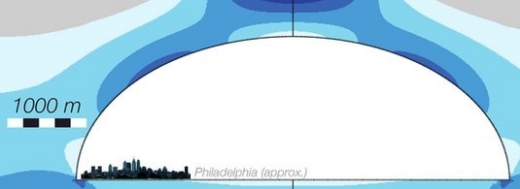
Image: A recent study, “Determining the Structural Stability of Lunar Lava Tube,” has suggested that lunar lava tubes may be much larger than terrestrial lava tubes, due to low gravity, as well as being geologically stable; cf. Lava Tube Moon Base.
How we get where we need to be
The maintenance or acceleration of the STEM cycle coincides with averting stagnation. As long as civilization is driven forward by unexpected and unprecedented developments in science, technology, and engineering, social transformations driven by technological transformations are likely to prevent our civilization from stagnating across the board. It would be surprising if there were not regional and limited forms of stagnation, but as long as some aspect of our civilization is breaking new ground there is a source of continued change being infused into civilization.
What can be done? How can the STEM cycle be maintained, if not accelerated? How can we avert stagnation? We can prioritize scientific projects that are likely to disproportionately contribute to the overall growth of scientific knowledge. The construction of a radio telescope on the far side of the moon (as has been advocated by SETI astronomer Claudio Maccone [14]), shielded from the EM radiation of Earth, would be both a stimulation to the space program and would result in significant scientific discoveries. While on the far side of the moon building a radio telescope, we would want to build a large optical telescope as well.
A radio telescope on the far side of the moon would necessitate a robust communication network between the lunar facilities and scientific centers on Earth. A fast internet connection between Earth and this scientific outpost on the far side of the moon would be the first stage in a solar system wide internet (Heath Rezabek has called this a solarnet; there is already internet access on the ISS via crew support LAN). With a large computer installed in a lunar lava tube to process the data (it has been suggested that we build a supercomputer on the moon), we could begin the first stages of backing up our civilization, by storing as much of the world’s knowledge as possible in this extraterrestrial repository. The first steps of backing up our biosphere, with the lunar equivalent of the Svalbard seed vault, would follow. The next step beyond this, of course, is to do the same thing on Mars, minus the purpose-built radio telescope, but with a permanent human settlement and eventually a Martian Civilization independent of terrestrial civilization.
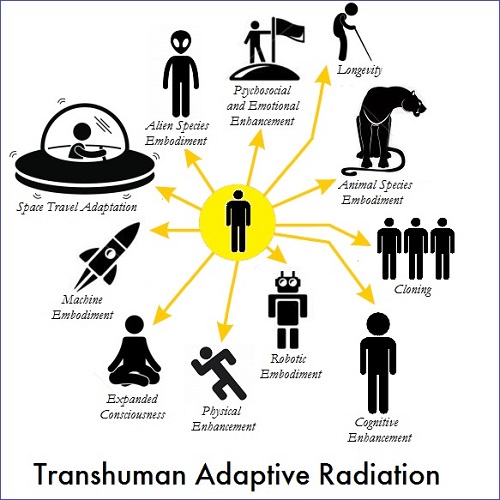
Image: Taken from an earlier Centauri Dreams post, Transhumanism and Adaptive Radiation, illustrating one aspect of the Great Voluntaristic Divergence, an adaptive radiation on a cosmological scale.]
What it might look like when we get there
Where are we going? To the stars, because that is the only undertaking sufficiently rigorous to indefinitely stimulate civilization and forestall stagnation. Our industrial-technological civilization is only about two hundred years old, and in much of the world it is far younger. We are as yet only on the cusp of the technological advancements intrinsic to this form of civilization. Once we have mastered the initial stages of technological development that come naturally to a planetary civilization, we will become a spacefaring civilization, because this is a challenge that can invigorate our civilization in the long term. [15] The stages mentioned above are mere steps in the buildout of terrestrial civilization toward an infrastructure that can sustain the exploration of the cosmos. The natural teleology of spacefaring civilization is interstellar, and then, beyond that, intergalactic travel, which will constitute the natural teleology of a multi-planetary species as it strives to multiply the planets on which it settles.
Steady advances in technology will eventually make interstellar spacefaring possible, and starships in turn will disproportionately contribute to the growth of scientific knowledge. Starships will be one more scientific instrument produced by the STEM cycle that will be employed in turn to advance scientific knowledge, and, as I have argued in The Scientific Imperative of Human Spaceflight, we will need human beings on these starships in order to derive the full benefit of scientific research. Robotic probes can expand scientific knowledge, but they cannot expand the range of a species, and even their scientific activities are limited by the absence of a conscious, embodied agent.
If the fractal structure of human history continues, we will see further exponential change at shorter time scales. A civilization at this next exponential growth stage following industrial-technological civilization is a spacefaring civilization that establishes itself as a multi-planetary species. And a spacefaring civilization is the kind of civilization that will ultimately lie at the source of what in “Transhumanism and Adaptive Radiation” I called the Great Voluntaristic Divergence. The individuals and communities that will project themselves into and onto the cosmos and thus exemplify the Great Voluntaristic Divergence, which will be marked by the self-selection of these individuals and communities, will each have their own idea of what constitutes the good for humanity, and each will act upon this idea to the exclusion of other ideas. On Earth, this process first led us into danger, which escalated into the planetary wars of the twentieth century, and then led us into stagnation, as the pursuit of mutually exclusive ideals came to be seen as an existential threat. In the context of countless worlds and almost unlimited resources, the cosmos is large enough to contain that which the Earth cannot allow: mutually exclusive central projects of planetary scale.
Perhaps this Great Voluntaristic Divergence will emerge not from Earth, but from Mars, as I recently speculated in Martian Civilization, as Martian civilization is more likely to converge upon scientific civilization than terrestrial civilization, burdened as the latter is by its long history and its many commitments to traditions arising from agricultural civilization. Martian civilization, as a de novo civilization of the industrial era, will begin as a technological civilization, and will develop from that point forward.
The idea of a cosmological expansion of terrestrial life and civilization—sometimes called the expansion hypothesis—has come under scrutiny in recent years, and appears almost as a relic of Stalinist gigantism or human hubris projected onto the universe entire. The environmental movement and the conservation ethic appear as the antithesis to technology and industrialism unconstrained even by the scope of Earth. Perhaps it will be more palatable for contemporary audiences to frame civilizations of cosmological scope in terms of divergence and diversification (i.e., biodiversity on a scale of which astrobiology can be the only adequate measure), and resilience and sustainability (sustainability for cosmologically significant periods of time), as the practical embodiment of expansion will exemplify these conservation ideals.
When civilization advances to the point of effectively eliminating technological and economic barriers to human endeavors, both individual human beings as well as human societies will be empowered to pursue projects that, by today’s standards, would be considered megalomaniacal in scope and ambition. While many will not choose such undertakings, the universe is large enough by any measure to accommodate anything conceivable by human beings, and can do so with room to spare. With the resources of the universe available to us, the point of the Great Voluntaristic Divergence is that we will not have to choose, because we will not be limited to a single planet whereupon only a single planetary civilization can play out its isolated development: one society can choose a small-is-beautiful paradigm of cooperative communities eating locally raised organic produce, while another builds megastructures, and neither need be bothered by the other.
If our civilization does not stumble again, as it has so frequently in the past, the Great Voluntaristic Divergence answers the question has to what development could follow the previous stages of exponential growth that have marked human history: outward expansion through the universe, as well as the diversification of terrestrial life as it embarks upon the greatest adaptive radiation in the history of life, which will be an adaptive radiation of both minds and bodies—corporeal and cognitive speciation on a cosmological scale. Unconstrained by the limits of a planetary biosphere or planetary civilization, life and civilization will become more diverse than we can conceptualize on the basis of life and civilization as they have been tightly constrained by the uniform selection pressures of a single planet.
Notes
[1] Completed in 1897 or 1898, it was difficult to find a buyer for the painting, through Gauguin regarded it as his masterpiece and the culmination of his life’s work. Today it hangs in the Museum of Fine Arts, Boston.
[2] Stephen of Byzantium famously said that, “Mythology is what never was, but always is.” On intuitive tractability, cf. my post The Overview Effect and Intuitive Tractability.
[3] Elsewhere I have suggested that encephalization is the great filter: Is encephalization the great filter? and Of Filters, Great and Small.
[4] In my last Centauri Dreams post, Martian Civilization, I discussed V. Gordon Childe’s conception of an “urban revolution” as the basis of civilization.
[5] Kenneth Clark, Civilisation: A Personal View, New York: Harper & Row, 1969, “The Skin of our Teeth” is the title of Chapter 1.
[6] My essay “The Moral Imperative of Human Spaceflight” attempts to provide an argument for the intrinsic value of human civilization, especially in sections 4-6. I also make this argument in the Afterword to my book Political Economy of Globalization.
[7] This argument need not be limited to human civilization, but can and ought to comprise all terrestrial-originating intrinsic value, which includes the uniqueness of the biosphere; for the sake of brevity, my exposition in the text is made in terms of civilization only.
[8] This tripartite approach to existential risk mitigation—knowledge, redundancy, and autonomy—was the subject of my joint presentation with Heath Rezabek at the 2013 Icarus Interstellar Starship Congress in Dallas, Texas, and can be found in our paper Xrisk 101: Existential Risk for Interstellar Advocates.
[9] The Founding Director of the Oxford Future of Humanity Institute, Prof. Nick Bostrom, has written a book about superintelligence, Superintelligence: Paths, Dangers, Strategies (also cf. the review of Bostrom’s book by Allan Dafoe and Stuart Russell, “Yes, We Are Worried About the Existential Risk of Artificial Intelligence“), while the FHI particularly identifies “AI Safety” as a particular area of research; The Future of Life Institute features the 23 “Asilomar AI Principles” on its website, which have been signed by more than 3,000 individuals (among them Elon Musk and Stephen Hawking) and An Open Letter: Research Priorities for Robust and Beneficial Artificial Intelligence, signed by more than 8,000 individuals; there is The Centre for Human Compatible AI at UC Berkeley; celebrities of science and technology such as Stephen Hawking and Elon Musk (both mentioned immediately above), and Michael Vassar have made public statements about the potential dangers of greater-than-human intelligence AI; these examples could be multiplied at will.
[10] Nick Bostrom, mentioned above in note [9], includes permanent stagnation among his classes of existential risk; cf. “Existential Risk Prevention as Global Priority,” Nick Bostrom, Global Policy, Vol. 4, Issue 1, Feb. 2013.
[11] Gilbert Murray, Five Stages of Greek Religion, Chapter IV, “The Failure of Nerve.” The first edition of Murray’s book was titled Four Stages of Greek Religion (1912), and did not include the final chapter of the later edition (added in 1925).
[12] Kenneth Clark, Civilisation: A Personal View, New York: Harper & Row, 1969, p. 4.
[13] These particular slogans are now quite dated, but the sentiment that they expressed has arguably become even more widespread than when the slogans were introduced.
[14] Cf. Claudio Maccone, “Lunar Farside Radio Lab,” Acta Astronautica, Volume 56, March 2005, Issue 6, p. 629-639. “The Farside of the Moon is a unique place, since it is the nearest (and only) place close to Earth to be totally free from man-made RFI. As such, the Farside is just humankind’s natural spot for conducting RFI-free radio explorations of all kinds, ranging from Cosmology to Astrophysics and the radio Contact with alien civilizations in the Universe (SETI).”
[15] Cf. my earlier Centauri Dreams post The Interstellar Imperative.

Skyscraper in the Clouds
Analemma seems the perfect name for the proposed ‘floating’ space tower being discussed by the Clouds Architecture Office, an imaginative New York firm whose unusual designs include a Martian habitat made of ice and a concept study of flight into deep space using comets for resources. An analemma is a diagram that traces the movement of the Sun in the sky as seen from a particular location on Earth. Over time, the position changes because of orbital eccentricity and our planet’s axial tilt, so that a slim figure-eight is the result.
That’s relevant to the Analemma tower because it is conceived as a huge construction tethered to an asteroid that would be moved into what the firm describes as ‘an eccentric geosynchronous orbit’ over Earth. The orbit allows the structure to move between the northern and southern hemispheres, tracing out a figure-eight over the surface. With the slowest speed over the ground at the top and bottom of the figure-eight, Clouds Architecture Office suggests that occupants could move back and forth, interacting with ground resources at these points. New York City is suggested as the location for one of the slow parts of the preferred orbit.
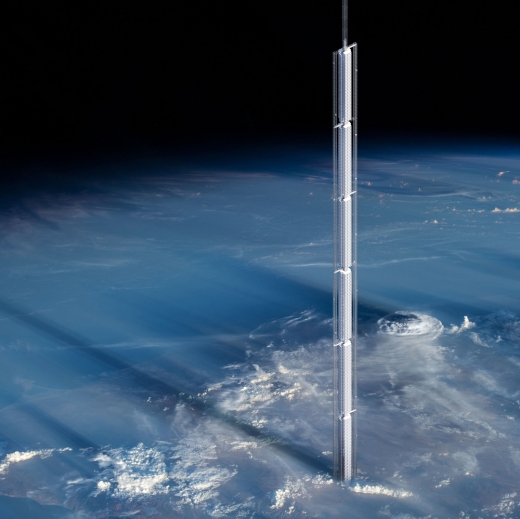
Image: Analemma inverts the traditional diagram of an earth-based foundation, instead depending on a space-based supporting foundation from which the tower is suspended. This system is referred to as the Universal Orbital Support System (UOSS). By placing a large asteroid into orbit over earth, a high strength cable can be lowered towards the surface of earth from which a super tall tower can be suspended. Since this new tower typology is suspended in the air, it can be constructed anywhere in the world and transported to its final location. The proposal calls for Analemma to be constructed over Dubai, which has proven to be a specialist in tall building construction at one fifth the cost of New York City construction. Credit (text and image): Clouds Architecture Office.
A skyscraper without a foundation on Earth? The concept makes for a great science fiction backdrop, if nothing else, and calls up images of a building so tall that occupants of its highest floors would look out upon the world from 32000 meters, with near vacuum conditions outside. Solar panels at the top would supply power, with water being supplied and replenished from clouds and rainwater. A transfer station would allow people and goods to move between the orbiting tower and the surface. As for the cost of building such a tower, one prefabricated unit at a time, plugging modules into an extendable core, the firm sees clear skies:
Harnessing the power of planetary design thinking, it taps into the desire for extreme height, seclusion and constant mobility. If the recent boom in residential towers proves that sales price per square foot rises with floor elevation, then Analemma Tower will command record prices, justifying its high cost of construction.
Want to get in on the ground floor? Not me. There’s plenty to question about this operation even if a market did emerge to support it, but the visuals are breathtaking, with spectacular vistas from residential windows aboard the building (craft?) and the futuristic imagery of a skyscraper emerging slowly out of the clouds for those below. Clouds Architecture Office trades off recent space news like the European Space Agency’s study of and landing on Comet 67P/Churyumov–Gerasimenko and NASA efforts at asteroid retrieval, which involve relocating a tiny asteroid to a new orbit. We’re already landing on comets and talking about moving asteroids, right, so why not stretch out the notion that much further? But Analemma Tower is a long, long stretch indeed.

Image: The Analemma Tower as it might appear over New York City. Credit: Clouds Architecture Office.
If it were ever built, the tower would certainly be an unusual place to live. The bottom of the structure is seen as a shopping and dining area. The firm talks about business being conducted above this zone in the lower and middle sections of the tower, with the residential quarters approximately ? of the way up. The sizes and shapes of the windows in the building would change with height because of the pressure and temperature differentials Analemma would experience. Those at the top of the tower would receive an additional 40 minutes of daylight per day because of the curvature of the Earth, says the Clouds Architecture Office website.

Image: Views through the windows of the Analemma tower, their shapes adapting to conditions outside. Credit: Clouds Architecture Office.
Because Dubai is the home of the world’s tallest building, Burj Khalifa, it is the firm’s choice for construction of the modules that would make up the tower. Exactly how building components would be delivered from the ground to the gradually growing core is not clear. Images of people parachuting past the tower’s windows suggest one quick way to the surface, though hardly one the average business person would be likely to take.
Can we create cables to support such a structure? And what about moving a sizeable asteroid into Earth orbit? NASA’s own plans in its Asteroid Redirect Mission have called for nudging a multi-ton boulder and pushing it into a stable orbit around the Moon, where it could be the destination of a manned mission that would bring samples back to Earth. That’s a $1.25 billion project in itself. The size of the asteroid Clouds Architecture Office is talking about isn’t specified, though it would far exceed the small rock NASA hopes to maneuver.
And consider the point that Sara Chodosh brought up in Popular Science in a piece appropriately titled This building hanging from an asteroid is absurd – but let’s take it seriously for a second. What happens to residents in a building this tall when they need an elevator?
The fastest elevators in the world are in The Shanghai Tower and move at 20.5 meters per second, so a straight shot to the top of the Analemma would take you just over 20 minutes. And that’s assuming there is a single elevator that goes all the way to the top. One of the logistically challenging things about building very tall structures is how you fit in enough elevators… The easiest way around that is to not require all of the elevators to go all the way to the ground (STRIKETHROUGH), er, first floor. You can stack elevator shafts on top of each other and simply have sky lobbies. So maybe you take an elevator from floor 1 to floor 50, then get off and take another from 50 to 100, and so on. Keep in mind that you’ll have to wait for the elevator to come each time, and with thousands upon thousands of residents you’ll probably be waiting a while.
Indeed. But there’s something to be said for black sky dreaming, and I love the visuals here. So while I’m not expecting to see Analemma appearing in the sky over New York any time soon, I do get some of the same buzz from the concept that I find in good science fiction. In fact, Analemma reminds me of some of Alastair Reynolds’ creations, particularly the world he portrays in novels like Chasm City (in his Revelation Space sequence). Chasm City is packed with mile-high skyscrapers, its planet surrounded by the Glitter Band, thousands of orbital habitats, all of which are threatened in the novel.
The people behind Analemma Tower have to be science fiction buffs. So why keep this idea on Earth? Geoffrey Landis has pointed out that at 50 kilometers above the surface of Venus, the pressure is about 1 bar and temperatures range between 0° and 50° Celsius. Here we wouldn’t need to be tethered to an asteroid, but could set up floating colonies in the Venusian clouds, where a human breathable air mixture is itself a lifting gas. Michael McCollum has likewise envisioned floating cities in the atmospheres of the outer gas giants. A skyscraper emerging out of the clouds may indeed be in our future, but I’m not sure Earth will be where we build it.
A note to the readers: Please help me out with further science fiction references on floating buildings/cities. I’m struggling to remember one recent depiction of a floating structure that moved between planet-bound cities — was it in Stephenson’s Seveneves, in the far future section of the novel? If so, I can’t find it. Your help on this is appreciated.

A Retrograde Asteroid Sharing Jupiter’s Orbit
We recently looked at JAXA’s planned solar sail mission to Jupiter (see JAXA Sail to Jupiter’s Trojan Asteroids), but I want to come back around to the Trojans this morning in light of a discovery announced today. The more we learn about the Trojans, the better. Most appear to be class D asteroids, dark with reddish hues and probably covered in tholins, organic polymers that result from the solar irradiation of organic compounds. Tholins show up all over the place in the outer system’s icy objects, adding to the view that the Jupiter Trojans were probably captured into their present orbits during the early days of Solar System formation.
Asteroid 2015 BZ509, discovered by the Panoramic Survey Telescope and Rapid Response System (Pan-STARRS) in 2015, turns out to be a Trojan with a difference. Revealed in the current issue of Nature by discoverers Paul Wiegert (Western University, London), Martin Connors (Athabasca University, CA) and Christian Veillet (Large Binocular Telescope Observatory, Tucson), the object is a Trojan moving in a retrograde orbit. [Addendum: See the comments below, where some writers question my use of the term ‘trojan’ to describe this object].
We think of Trojans as moving in the same direction as Jupiter, though offset from the giant planet by 60° ahead or behind (at the L4 or L5 Lagrangian points), so this object is a surprise. While a few non-Trojan asteroids do orbit the Sun in retrograde orbits, 2015 BZ509 is in a tight relationship with Jupiter, tracking its orbit in reverse in a way that allows it to weave out of the planet’s path each time they approach each other.
Image: The co-orbital asteroids of Jupiter, also known as the ‘Trojan asteroids’. The prograde asteroids are shown in white, and 2015 BZ509 (with a trail, shown in green) appears later. The planets and asteroids have been enlarged for visibility. Credit: Wiegert et al.
The situation is stable as 2015 BZ509 passes once inside and once outside Jupiter each time they orbit the Sun, with Jupiter’s gravitational tugs on the planet canceling out to maintain the relationship. The condition is called a retrograde co-orbital resonance, a topic explored by Anthony Dobrovolskis (NASA Ames) in 2012, and followed up on by Helena Morais (Universidade de Estadual Paulista, Brazil) and Fathi Namouni (Université de Nice-Sophia Antipolis, France) in the years following. Their work established the theoretical existence of such objects, but 2015 BZ509 marks the first time an actual asteroid has been found in this kind of resonance. How it got there remains a mystery.
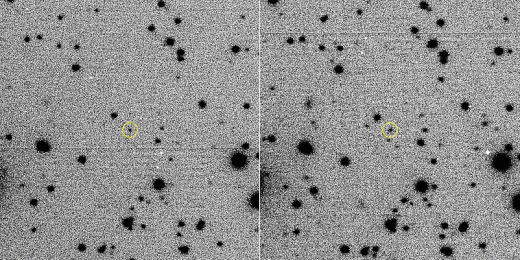
Image: Images of 2015 BZ509 obtained at the Large Binocular Telescope Observatory (LBTO) that established its retrograde co-orbital nature. The LBTO has two 8.4 meter-wide main mirrors side-by-side, hence the two images. The bright stars and the asteroid (circled in yellow) appear black and the sky white in this negative image. The white dots, spots and stripes are imaging artifacts in these raw images. Credit: Wiegert et al.
Although 2015 BZ509 never gets closer to Jupiter than 176 million kilometers, it is Jupiter’s gravity that controls its movements and keeps it from what would otherwise be a collision with that planet. We may be looking at an inactive comet nucleus here, although there is no sign as yet of cometary outgassing or the formation of a tail, which in any case might not form because of the asteroid’s distance from the Sun.
While its retrograde motion sets it apart, 2015 BZ509 joins the ranks of co-orbital asteroids that share a planet’s orbit, a list that includes Earth’s co-orbital 3753 Cruithne, 2010 SO16 and 2002 AA29. All of these are in a 1:1 mean motion resonance with our planet, meaning that they orbit the Sun in the same average amount of time that the Earth does.
The paper is Wiegert et al., “A retrograde co-orbital asteroid of Jupiter,” Nature 543 (30 March 2017), 687-689 (abstract).

